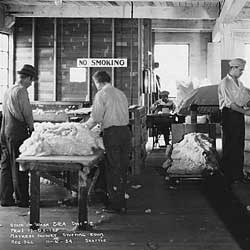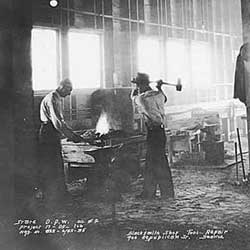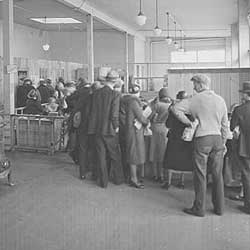Essay: The Federal Emergency Relief Administration
Essay: The Federal Emergency Relief Administration (FERA)
Sample Searches
- Road, bridge, street, railroad construction
- Waterway improvements
- Land clearing projects
- Park and playround maintenance
- School maintenance projects
- Workshops and training centers
- Water and sewer pipeline repairs
- Fuelwood gathering
- Relief centers and the homeless
Other Resources
The economic collapse of 1929 known as the Great Depression caused widespread hardship throughout the United States. When President Franklin Roosevelt took office in January 1933, 15 million Americans were unemployed. Many had lost not only their jobs, but their also their savings and homes and were dependent on relief money from the government to survive. Businesses and banks had closed, production and sales of goods and services had been severely reduced. Most federal relief efforts had been mired for some time in a quagmire of political and legislative wrangling. Little aid or direction had actually reached the state level.
On May 22, 1933, the Federal Emergency Relief Administration (FERA) was inaugurated. The chief architect of this program was Harry Hopkins, the former president and executive director of the New York State Temporary Emergency Relief Administration and a man who had, by 1933, 20 years of experience in social work and welfare administration. He had worked with (then Governor) Franklin Roosevelt in New York, and the two became good friends, with Hopkins serving as Roosevelt's chief advisor and confidant throughout his administration.
Hopkins sprang into action less than a week after Roosevelt's inauguration, approaching Roosevelt's secretary of labor, Frances Perkins, with a plan for a program of federal relief. Impressed, Perkins agreed to take the proposal to Roosevelt, who quickly agreed to the plan.
"When Roosevelt appointed Hopkins as director of FERA, he called him to his office for a five-minute talk. The president told the Washington newcomer two things: give immediate and adequate relief to the unemployed, and pay no attention to politics or politicians. Hopkins did just that. Thirty minutes later, seated at a makeshift desk in a hallway . he began a program committed to action rather than debate, a program that would eventually put 15 million people to work. Even more important, FERA established the doctrine that adequate public relief was a right that citizens in need could expect to received from their government." (J. Hopkins p. 309)
FERA had three primary objectives: 1) Adequacy of relief measures; 2) providing work for employable people on the relief rolls; and 3) diversification of relief programs.
FERA accepted as elementary that all needy persons and their dependents should receive sufficient relief to prevent physical suffering and to maintain a minimum standard of living." (Williams p. 96) In a report to Congress in 1936, FERA indicated that while actual physical suffering was prevented, it was never fully possible to achieve living standards of minimum decency for the entire population in need of relief.
It has been estimated that during this period of relief, roughly three-fourths of the heads of families on relief were employable. They may not have been generally employable in private industry due to age, but they were considered employable by FERA. The FERA's goals for work relief included not only genuine work (as opposed to "make work projects") but also work opportunities that were sufficiently diversified to give relief workers employment in line with their previous job experience. The working conditions and wages also had to be in line with those found in the private sector.
The purpose of FERA was to work cooperatively with state government, providing federal grants for relief purposes. Grant applications required that states were to provide information on the amounts necessary to meet relief needs in the state and the amounts available from public and private sources within the state to contribute toward those relief needs. States also were to provide information on provisions made to assure adequate administrative supervision of the funds, the methods by which adequate relief levels would be assured, and the purposes for which the funds would be used. The provisions of the Federal Emergency Relief Act of 1933 provided that authorization for FERA would expire in two years from the date of inception.
The most pressing problem for FERA at first was to build up adequate local relief organizations. Few of the existing state relief agencies had been in existence for more than 7 or 8 months at the time of creation of FERA. Those state relief agencies that were deemed to be inadequate or flawed in some way had to be overhauled to meet the requirements of FERA.
Most states had little experience with running genuine work relief programs and almost no experience in providing appropriate work for white-collar workers. Despite directives and orders issued in 1933, states and localities were not quick to cooperate by accepting federal projects. Either through inertia or a desire to institute projects of purely local interest and benefit, state involvement in work relief programs were slow to start in 1933. Faced with continued high unemployment and concerns for public welfare during the coming winter of 1933-34, FERA institute the Civil Works Administration (CWA) as a short-term measure to get people to work.
As the CWA program drew to a close in March 1934, it was replaced by the Emergency Work Relief Program of FERA. This program continued and expanded many of the projects begun under the CWA.
The bulk of the work relief projects, were engineering and construction oriented. Other projects included sanitation improvements, repair or construction of public buildings, national park improvements, real property surveys, library projects, art and theater projects, and archeological excavations. The Washington Emergency Relief Administration (WERA) supervised numerous construction and repair projects in the state. In Seattle, it built the Montlake playfield field house and the Montlake Community Clubhouse, which has since acquired the name "Tudor Building," after its architecture. Other projects in Washington were of an agricultural nature. Among these were a rural electric survey of the state, research on the development of new fruit by-products, research to determine the vitamin C content in Washington apples, a survey of part-time farming, and research on the use of by-products of the fishing industry as feed for the poultry industry. (WSU MASC)
The Emergency Work Relief Program provided for three special classes of projects for white-collar workers: 1) Planning; 2) public health, welfare and recreation; 3) education, arts and research. ." It had been estimated that there were about 560,000 white-collar workers between the ages of 16 and 64 on the relief rolls in March 1935, approximately 11 percent of all employable persons on relief rolls at this time. "Federal encouragement of white-collar projects has been productive of more bitter criticism than any other single activity of the various federal relief agencies.Much of the criticism.has arisen from a misunderstanding of the peculiar problems which beset the relief agencies in attempting to meet adequately the relief needs of those white-collar workers who were forced to apply for relief."
"During 1932 and 1933 a growing number of unemployed teachers applied for relief after their resources had become exhausted. Shortly after the FERA was initiated we attempted to do something for this group of needy teachers. Obviously it was hardly enough to give them direct relief. With thousands of teachers out of work there were, at the same time, hundreds of thousands of men and women in need of educational facilities. We decided to put these unemployed teachers to work teaching those unemployed who wanted instruction." (H. Hopkins p. 113)
In March 1935, at the peak of the emergency education program, more than 44,000 persons were employed and the number of pupils was slightly higher than 1,724,000. Each state could choose to develop or emphasize any or all of the following, depending on local conditions: 1) General adult education; 2) literary classes for adults; 3) vocational education; 4) vocational rehabilitation; and 5) nursery schools for pre-school children from underprivileged homes.
Another part of the emergency education program was the college student aid program. It provided part-time employment for those college students who would otherwise have been unable to continue their education. The projects for the students were planned and supervised in large part by the college authorities.
Funds through the emergency education program were made available for student employment at Washington State University (WSU) in Pullman from 1934 to 1936. During part of this time period there were also funds available through the Civil Works Administration but these were primarily for public works projects. The FERA funds at WSU were administered by a Central Faculty Committee made up of the Dean of Men, the Dean of Women, the Superintendent of the Central Correspondence Office and one faculty member. The Committee operated through the office of the Dean of Men.
The requirements for the use of the funds were that they be used to employ not more that 10% of the total full time student population, of which 25% had to be students not previously enrolled. Although the FERA funds enabled many students to attend WSU who could not otherwise afford to, the program was terminated in 1936 when this relief activity was transferred to the Works Progress Administration.
Prior to FERA, few efforts were made to institute special projects for women. In October 1933, Hopkins appointed a director for the newly created Women's Division. FERA also ordered states to appoint a qualified woman to head a women's division in each state agency. These agencies were to plan special projects that would benefit women and to exert pressure on other divisions of state relief agencies to insure that women had equal consideration for work opportunities for which they were qualified.
"Among the projects providing work for women were sewing room projects in which clothing, bedding, towels, etc., were fabricated for distribution to persons on relief rolls; food canning projects; nursing and teaching projects; and various research and statistical surveys." (Williams p. 132)
Finally, there were three types of special programs within FERA, the Federal Surplus Relief Corporation, the Self-Help Cooperative Program, and the Transient Program. The Federal Surplus Relief Corporation had two main purposes. First, it helped keep farmers above the destitution level by serving as an agency for removing price-depressing surplus commodities from the open market. Secondly, it served as the agency through which these surplus commodities were made available to the state and local relief administrations for distribution to relief clients. At times, processing of the commodities was done by work divisions of the state relief agencies.
The Self-Help Cooperative Program was a small part of FERA which had as its mission to help existing grassroots cooperatives produce goods for themselves and to facilitate the exchange or barter of other goods needed by the members of the cooperative but which could not be produced within this group. The program also helped groups that wished to start cooperatives.
"The need for a special program for transients soon became manifest. Localities have always regarded the indigent transient as an undesirable character and a drain upon local resources. During the depressing this age-old dislike was fanned by the fear that a non-resident who was seeking relief might at any moment take some job which 'properly' belonged to a local person." (Williams p. 147)
The Transient Division of FERA was established in July 1933, volunteering to furnish all the necessary funds for a transient program in those states that drew up an approved plan for dealing with transients. "Local antagonism toward transients was so great, however, that despite the fact that no state and local funds were required, only a few states had applied for funds before September 1933." (Williams p. 148) It was not until late in December that 40 states and the District of Columbia were operating transient programs. Most states required a period of residence of one year to qualify for relief in that state, and FERA accepted this. FERA defined as a transient one who had lived less than the twelve preceding months in the state in which he was applying for aid.
During the period of over two years that the program was in existence, transient relief bureaus existing in most large cities and along the main travel routes. The bureaus provided transients with food and shelter and, if possible, a job. At times, large transient camps were set up on the outskirts of cities.
FERA and the Seattle Salvation Army collaborated in the operation of shelters for homeless men at two locations in Seattle: 213-1/2 Second Avenue South (the former United States Immigration Building) and at 117-1/2 Main Street. Because of Seattle's position as a gateway city to the Pacific and to Alaska, transients who visited the shelters came from all over the United States and even from foreign nations. Because Federal Emergency Relief Act of 1933 mandated that FERA should end two years after its inception, a new program was needed to take its place. The program put in place was called the Works Progress Administration (WPA), and it took over and improved the programs put in place by FERA. The WPA was created May 6, 1935, by authority of the Emergency Relief Appropriate Act of 1935.
References Consulted
Hopkins, Harry L. Spending to save: the complete story of relief. Seattle: University of Washington Press, 1936.
Hopkins, June. "The road not taken: Harry Hopkins and New Deal Work Relief." Presidential Studies Quarterly 29, 2(306-316).
Washington State University Libraries Special Collections web site. Accessed July 31, 2003. https://content.libraries.wsu.edu/digital/custom/collections
Williams, Edward Ainsworth. Federal aid for relief. New York: Columbia University Press, 1939.





